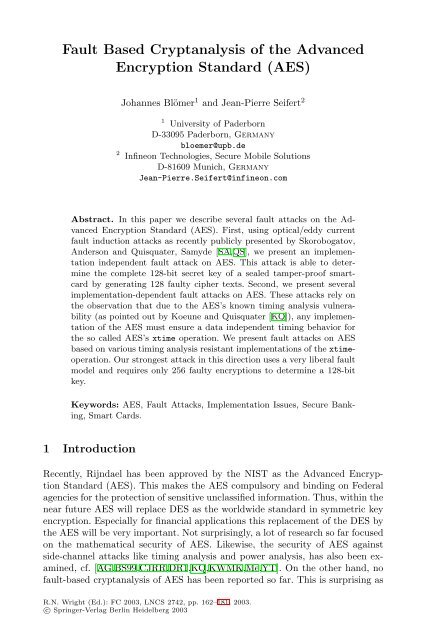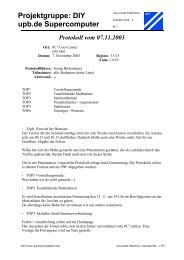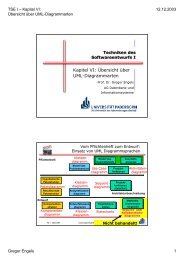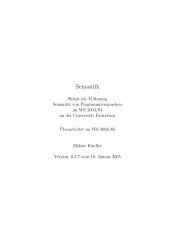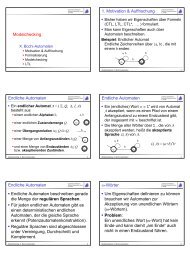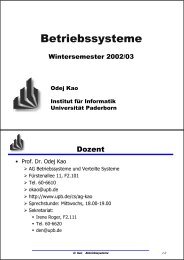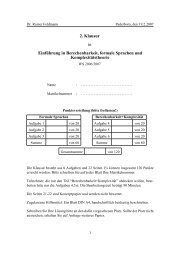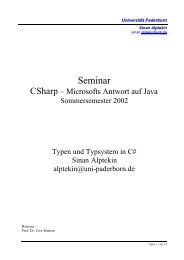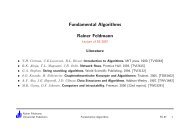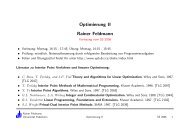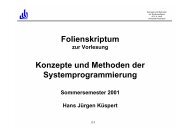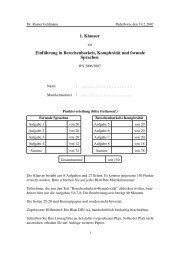Fault Based Cryptanalysis of the Advanced Encryption Standard (AES)
Fault Based Cryptanalysis of the Advanced Encryption Standard (AES)
Fault Based Cryptanalysis of the Advanced Encryption Standard (AES)
Create successful ePaper yourself
Turn your PDF publications into a flip-book with our unique Google optimized e-Paper software.
<strong>Fault</strong> <strong>Based</strong> <strong>Cryptanalysis</strong> <strong>of</strong> <strong>the</strong> <strong>Advanced</strong><br />
<strong>Encryption</strong> <strong>Standard</strong> (<strong>AES</strong>)<br />
Johannes Blömer 1 and Jean-Pierre Seifert 2<br />
1 University <strong>of</strong> Paderborn<br />
D-33095 Paderborn, Germany<br />
bloemer@upb.de<br />
2 Infineon Technologies, Secure Mobile Solutions<br />
D-81609 Munich, Germany<br />
Jean-Pierre.Seifert@infineon.com<br />
Abstract. In this paper we describe several fault attacks on <strong>the</strong> <strong>Advanced</strong><br />
<strong>Encryption</strong> <strong>Standard</strong> (<strong>AES</strong>). First, using optical/eddy current<br />
fault induction attacks as recently publicly presented by Skorobogatov,<br />
Anderson and Quisquater, Samyde [SA,QS], we present an implementation<br />
independent fault attack on <strong>AES</strong>. This attack is able to determine<br />
<strong>the</strong> complete 128-bit secret key <strong>of</strong> a sealed tamper-pro<strong>of</strong> smartcard<br />
by generating 128 faulty cipher texts. Second, we present several<br />
implementation-dependent fault attacks on <strong>AES</strong>. These attacks rely on<br />
<strong>the</strong> observation that due to <strong>the</strong> <strong>AES</strong>’s known timing analysis vulnerability<br />
(as pointed out by Koeune and Quisquater [KQ]), any implementation<br />
<strong>of</strong> <strong>the</strong> <strong>AES</strong> must ensure a data independent timing behavior for<br />
<strong>the</strong> so called <strong>AES</strong>’s xtime operation. We present fault attacks on <strong>AES</strong><br />
based on various timing analysis resistant implementations <strong>of</strong> <strong>the</strong> xtimeoperation.<br />
Our strongest attack in this direction uses a very liberal fault<br />
model and requires only 256 faulty encryptions to determine a 128-bit<br />
key.<br />
Keywords: <strong>AES</strong>, <strong>Fault</strong> Attacks, Implementation Issues, Secure Banking,<br />
Smart Cards.<br />
1 Introduction<br />
Recently, Rijndael has been approved by <strong>the</strong> NIST as <strong>the</strong> <strong>Advanced</strong> <strong>Encryption</strong><br />
<strong>Standard</strong> (<strong>AES</strong>). This makes <strong>the</strong> <strong>AES</strong> compulsory and binding on Federal<br />
agencies for <strong>the</strong> protection <strong>of</strong> sensitive unclassified information. Thus, within <strong>the</strong><br />
near future <strong>AES</strong> will replace DES as <strong>the</strong> worldwide standard in symmetric key<br />
encryption. Especially for financial applications this replacement <strong>of</strong> <strong>the</strong> DES by<br />
<strong>the</strong> <strong>AES</strong> will be very important. Not surprisingly, a lot <strong>of</strong> research so far focused<br />
on <strong>the</strong> ma<strong>the</strong>matical security <strong>of</strong> <strong>AES</strong>. Likewise, <strong>the</strong> security <strong>of</strong> <strong>AES</strong> against<br />
side-channel attacks like timing analysis and power analysis, has also been examined,<br />
cf. [AG,BS99,CJRR,DR1,KQ,KWMK,Me,YT]. On <strong>the</strong> o<strong>the</strong>r hand, no<br />
fault-based cryptanalysis <strong>of</strong> <strong>AES</strong> has been reported so far. This is surprising as<br />
R.N. Wright (Ed.): FC 2003, LNCS 2742, pp. 162–181, 2003.<br />
c○ Springer-Verlag Berlin Heidelberg 2003
<strong>Fault</strong> <strong>Based</strong> <strong>Cryptanalysis</strong> <strong>of</strong> <strong>the</strong> <strong>Advanced</strong> <strong>Encryption</strong> <strong>Standard</strong> (<strong>AES</strong>) 163<br />
<strong>the</strong> frauds with smartcards by inducing faults are real, cf. [A,AK1,AK2], whereas<br />
no frauds via Timing or Power Analysis attacks have been reported so far.<br />
In this paper we describe several methods for a fault based cryptanalysis <strong>of</strong><br />
<strong>AES</strong>. We present an implementation independent attack as well as attacks on<br />
several implementations <strong>of</strong> <strong>AES</strong> aimed at making <strong>AES</strong> timing analysis secure.<br />
Several different fault models are used in our attacks. The first attack is<br />
implementation independent but uses <strong>the</strong> most restrictive fault model. It is<br />
aimed at <strong>the</strong> first transformation during an encryption with <strong>AES</strong>, <strong>the</strong> so called<br />
AddRoundKey. In this attack we use a ra<strong>the</strong>r strong but seemingly realistic fault<br />
model. We assume, that an attacker can set a specific memory bit to a fixed<br />
value, e.g., to <strong>the</strong> value 0. Moreover, we assume that <strong>the</strong> attacker can do this<br />
at a precise time <strong>of</strong> his choice. The practicality <strong>of</strong> this model has recently been<br />
demonstrated in [SA,QS]. Using this model we show that an attacker can determine<br />
<strong>the</strong> complete 128-bit secret key by computing 128 encryptions inducing<br />
a single fault each time. We also show that <strong>the</strong> fault model can be relaxed in<br />
two ways. First, an attacker need not be able to set a fixed memory bit with<br />
probability 1 to <strong>the</strong> value 0, say. Instead, it is sufficient that <strong>the</strong> value <strong>of</strong> a<br />
certain a bit will be changed with slightly higher probability from 1 to 0 than<br />
from 0 to 1. Second, we show that <strong>the</strong> attacker need not be able to change <strong>the</strong><br />
bit at a precise point in time. Hence, to fend <strong>of</strong>f <strong>the</strong> attack it is not sufficient<br />
to equip a cryptographic device with a randomized timing behavior. We note<br />
that our implementation independent attack can also be mounted against o<strong>the</strong>r<br />
symmetric encryption ciphers like IDEA, SAFER, and Blowfish. In fact, like<br />
<strong>AES</strong>, <strong>the</strong>se ciphers have an initial key addition. This alone renders <strong>the</strong>m immediately<br />
susceptible to our implementation independent attack. We like to point<br />
out that our basic attack scenario is similar to an attack scenario described in<br />
[BS97]. However, our attack scenario is much simpler to realize and especially<br />
more practically oriented towards real threats.<br />
Our second class <strong>of</strong> attacks are implementation dependent. More precisely, we<br />
consider several different implementations for <strong>the</strong> so called xtime operation that<br />
is performed during <strong>the</strong> transformation MixColumn. As it is well-known, <strong>AES</strong> is<br />
susceptible to timing attacks if xtime is not implemented appropriately. We consider<br />
various timing attack resistant implementations and show that all <strong>of</strong> <strong>the</strong>m<br />
lead to a simple fault based cryptanalysis <strong>of</strong> <strong>AES</strong>. The various implementations<br />
we consider vary from s<strong>of</strong>tware solutions to hardware based implementations.<br />
Definitely, we do not consider all implementations <strong>of</strong> xtime currently in use.<br />
However, we are confident that most if not all implementations are susceptible<br />
to <strong>the</strong> attacks described in this paper. The fault models we use in <strong>the</strong> attacks<br />
range from very liberal models (arbitrary fault at a specific location) to more<br />
restricted models, like <strong>the</strong> one we use in <strong>the</strong> implementation independent attack.<br />
Our strongest result shows that <strong>the</strong> most obvious timing attack resistant<br />
implementation <strong>of</strong> xtime opens <strong>the</strong> door for a simple fault based attack on <strong>AES</strong>.<br />
With this attack <strong>the</strong> complete secret key can be determined encrypting roughly<br />
256 plaintexts. In each encryption an attacker must induce an arbitrary fault at<br />
a specific memory byte. Using <strong>the</strong> methods we describe for <strong>the</strong> implementation
164 J. Blömer and J.-P. Seifert<br />
independent attack, one can argue, that it is not necessary for <strong>the</strong> attacker to<br />
induce <strong>the</strong> fault at a specific time. We like to point out that our implementation<br />
dependent attacks use a technique introduced by [KQ] and were inspired<br />
by ideas in [YJ].<br />
In all our attacks we assume, that from <strong>the</strong> behavior <strong>of</strong> a cryptographic<br />
device we can deduce whe<strong>the</strong>r a fault leading to a wrong ciphertext has actually<br />
occurred during an encryption. If a fault occurs, <strong>the</strong> device may simply output<br />
a wrong ciphertext. However, an attacker can compute <strong>the</strong> correct ciphertext by<br />
rerunning <strong>the</strong> device without inducing a fault, <strong>the</strong>reby detecting whe<strong>the</strong>r a fault<br />
occured during <strong>the</strong> original encryption. The device may also check its own result,<br />
or may even check intermediate results and answer with an error warning in case<br />
a fault has been detected (see [KWMK]). This clearly tells an attacker that a<br />
fault has occurred. Thirdly, <strong>the</strong> card may check whe<strong>the</strong>r a fault has occurred,<br />
and if so, recompute <strong>the</strong> encryption. However, in this case by measuring <strong>the</strong><br />
time before <strong>the</strong> device outputs <strong>the</strong> ciphertext, an attacker can tell whe<strong>the</strong>r a<br />
fault occurred. To simplify <strong>the</strong> presentation, we assume that a cryptographic<br />
device will answer with <strong>the</strong> output reset, whenever a fault caused a wrong<br />
ciphertext.<br />
From <strong>the</strong> results in this paper, it follows that it is absolutely necessary to<br />
incorporate both hardware and s<strong>of</strong>tware means into <strong>AES</strong> realizations to guard<br />
against fault attacks. Of course, some modern high-end crypto smartcards are<br />
protected by various sophisticated hardware mechanisms to detect any intrusion<br />
attempt to <strong>the</strong>ir system behavior. However, as techniques to induce faults into<br />
<strong>the</strong> computations <strong>of</strong> smartcards become more sophisticated, it is mandatory to<br />
use also various s<strong>of</strong>tware mechanisms to fend <strong>of</strong>f fault attacks. We like to close<br />
with an advice due to Kaliski and Robshaw [KR] from RSA Laboratories that<br />
good engineering practices in <strong>the</strong> design <strong>of</strong> secure hardware are essential, we only<br />
would like to add, that <strong>the</strong> same applies to secure s<strong>of</strong>tware.<br />
The paper is organized as follows. We first describe <strong>the</strong> <strong>AES</strong> algorithm. In<br />
<strong>the</strong> next section we briefly turn to <strong>the</strong> physics <strong>of</strong> realizing faults during computations.<br />
In particular, we sketch and characterize <strong>the</strong> physical attacks used by us<br />
in later sections. The following section <strong>the</strong>n describes our general independent<br />
fault attack on <strong>AES</strong>. In this section we also describe <strong>the</strong> two aforementioned<br />
relaxations concerning a probabilistic fault model and a loose time control on<br />
<strong>the</strong> induced error. The next section starts with <strong>the</strong> explanation <strong>of</strong> <strong>the</strong> basic idea<br />
for all <strong>of</strong> our implementation dependent fault attacks. Then, we will continue to<br />
describe incrementally more and more sophisticated fault attacks. Eventually,<br />
we give some hints on conceivable countermeasures to defeat our fault attacks<br />
on <strong>the</strong> <strong>AES</strong>.<br />
2 Preliminaries<br />
2.1 Description <strong>of</strong> <strong>the</strong> <strong>Advanced</strong> <strong>Encryption</strong> <strong>Standard</strong><br />
In this section we briefly describe <strong>the</strong> <strong>Advanced</strong> <strong>Encryption</strong> <strong>Standard</strong> (<strong>AES</strong>).<br />
For a more detailed description we refer to [DR2].
<strong>Fault</strong> <strong>Based</strong> <strong>Cryptanalysis</strong> <strong>of</strong> <strong>the</strong> <strong>Advanced</strong> <strong>Encryption</strong> <strong>Standard</strong> (<strong>AES</strong>) 165<br />
<strong>AES</strong> encrypts plaintexts consisting <strong>of</strong> lb bytes, where lb =16, 24, or 32.<br />
The plaintext is organized as a (4 × Nb) array (aij), 0 ≤ i
166 J. Blömer and J.-P. Seifert<br />
are shifted by C1,C2,C3 bytes, respectively, where <strong>the</strong> values <strong>of</strong> <strong>the</strong> Ci depend<br />
on Nb.<br />
The transformation MixColumn. The transformation MixColumn is crucial to<br />
some <strong>of</strong> our attacks. The transformation MixColumn operates on <strong>the</strong> columns <strong>of</strong><br />
a state separately. To each column a fixed linear transformation is applied. To<br />
do so, bytes are interpreted as elements in <strong>the</strong> field F28. As is usually done, we<br />
will denote elements in this field in hexadecimal notation. Hence 01, 02 and 03<br />
correspond to <strong>the</strong> bytes 00000001, 00000010, and 00000011, respectively. Now<br />
MixColumn applies to each row <strong>of</strong> a state <strong>the</strong> linear transformation defined by<br />
<strong>the</strong> following matrix<br />
⎡<br />
⎤<br />
02 03 01 01<br />
⎢ 01 02 03 01 ⎥<br />
⎣ 01 01 02 03 ⎦ . (1)<br />
03 01 01 02<br />
The operation xtime. The multiplications in F 2 8 necessary to compute <strong>the</strong> transformation<br />
MixColumn are <strong>of</strong> great importance to some <strong>of</strong> our attacks. Therefore<br />
we are going to describe <strong>the</strong>m in more detail. First we need to say a few words<br />
about <strong>the</strong> representation <strong>of</strong> <strong>the</strong> field F 2 8. In <strong>AES</strong> <strong>the</strong> field F 2 8 is represented as<br />
F 2 8 = F2[x]/(x 8 + x 4 + x 3 + x +1). (2)<br />
That is, elements <strong>of</strong> F 2 8 are polynomials over F2 <strong>of</strong> degree at most 7. The addition<br />
and multiplication <strong>of</strong> two polynomials is done modulo <strong>the</strong> polynomial x 8 + x 4 +<br />
x 3 +x+1. Since this is an irreducible polynomial over F2, (2) defines a field. In this<br />
representation <strong>of</strong> F 2 8 <strong>the</strong> byte a =(a7,... ,a1,a0) corresponds to <strong>the</strong> polynomial<br />
a7x 7 + ···a1x + a0. The multiplication <strong>of</strong> an element a =(a7,... ,a1,a0) inF 2 8<br />
by 01, 02, and 03 is realized by multiplying <strong>the</strong> polynomial a7x 7 + ···a1x + a0<br />
with <strong>the</strong> polynomials 1,x,x+ 1, respectively, and reducing <strong>the</strong> result modulo<br />
x 8 + x 4 + x 3 + x + 1. Hence<br />
01 · a = a<br />
03 · a =02· a + a.<br />
We see that multiplying a column <strong>of</strong> a state by <strong>the</strong> matrix in (1) can be reduced<br />
to a number <strong>of</strong> additions modulo 2 and multiplications by 02. We consider <strong>the</strong><br />
multiplication by 02 in more detail. Following <strong>the</strong> notation in [DR2] we denote<br />
<strong>the</strong> multiplication <strong>of</strong> byte a by 02 by xtime(a). The crucial observation is that<br />
xtime(a) is simply a shift <strong>of</strong> byte a, followed in some cases by an xor <strong>of</strong> two<br />
bytes. More precisely, for a =(a7,... ,a0)<br />
⎧<br />
⎨ (a6,... ,a0, 0) if a7 =0<br />
xtime(a) =<br />
⎩<br />
(a6,... ,a0, 0) ⊕ (0, 0, 0, 1, 1, 0, 1, 1) if a7 =1<br />
This finishes our brief description <strong>of</strong> <strong>the</strong> <strong>AES</strong> encryption procedure.<br />
(3)
<strong>Fault</strong> <strong>Based</strong> <strong>Cryptanalysis</strong> <strong>of</strong> <strong>the</strong> <strong>Advanced</strong> <strong>Encryption</strong> <strong>Standard</strong> (<strong>AES</strong>) 167<br />
3 Physical <strong>Fault</strong>s Attacks<br />
Although <strong>the</strong>re are lots <strong>of</strong> possibilities to introduce an error during <strong>the</strong> cryptographic<br />
operation <strong>of</strong> an unprotected smartcard IC, we will only briefly explain so<br />
called spike attacks, glitch attacks and <strong>the</strong> recently developed optical/eddy current<br />
attacks. We selected <strong>the</strong>se attacks, as <strong>the</strong>y are so called non invasive attacks<br />
or at least only semi-invasive, meaning that <strong>the</strong>se methods require no physical<br />
opening, no chemical preparation nor an electrical contact to <strong>the</strong> chip’s metal<br />
surface. Therefore, <strong>the</strong>se attacks are <strong>the</strong> most obvious methods for attacking<br />
smartcard ICs by fault attacks. For a thorough treatment <strong>of</strong> tamper-resistance<br />
and especially on methods how to enforce erroneous computations <strong>of</strong> microcontroller<br />
chips we refer to [A,ABFHS,AK1,AK2,Gu1,Gu2,Koca,QS,SA,KK,Ma].<br />
Moreover, although <strong>the</strong> effects <strong>of</strong> applying physical stress via <strong>the</strong> above mentioned<br />
methods to a smartcard IC can be completely explained by numerous<br />
physical and technical considerations, <strong>the</strong>se explanations are clearly beyond <strong>the</strong><br />
scope <strong>of</strong> this paper, meaning that our physical explanations will be pretty rough.<br />
3.1 Spike Attacks<br />
As required by [ISO], a smartcard IC must be able to tolerate on <strong>the</strong> contact VCC<br />
a supply voltage between 4, 5V and 5, 5V, where <strong>the</strong> standard voltage is specified<br />
at 5V. Within this range <strong>the</strong> smartcard must be able to work properly. However,<br />
a deviation <strong>of</strong> <strong>the</strong> external power supply, called spike, <strong>of</strong> much more than <strong>the</strong><br />
specified 10% tolerance might cause problems for a proper functionality <strong>of</strong> <strong>the</strong><br />
smartcard IC. Indeed, it will most probably lead to a wrong computation result,<br />
provided that <strong>the</strong> smartcard IC is still able to finish its computation completely.<br />
Although a spike seems from <strong>the</strong> above explanation very simple, a specific<br />
type <strong>of</strong> a power spike is determined by altoge<strong>the</strong>r nine different parameters.<br />
These nine parameters are determined by a combination <strong>of</strong> time, voltage values,<br />
and <strong>the</strong> shape <strong>of</strong> <strong>the</strong> voltage transition. This indicates <strong>the</strong> range <strong>of</strong> different<br />
parameters which an attacker can try to modify in order to induce a fault.<br />
As spike attacks are non-invasive attacks, <strong>the</strong>y are <strong>the</strong> most obvious method<br />
for inducing computational faults on smartcard ICs. In particular, <strong>the</strong>y require<br />
no physical opening, no chemical preparation <strong>of</strong> <strong>the</strong> smartcard IC and do not<br />
require making an electrical contact to <strong>the</strong> IC’s metal surface.<br />
3.2 Glitch Attacks<br />
Similar to above, [ISO] prescribes that a smartcard IC must be able to tolerate<br />
on <strong>the</strong> clock contact CLK a voltage for VIH <strong>of</strong> 0, 7VCC,... ,VCC and for VIL<br />
<strong>of</strong> 0VCC,... ,0, 5VCC. Moreover, it must be also able to tolerate clock rise and<br />
clock fall times <strong>of</strong> 9% from <strong>the</strong> period cycle. Within this range <strong>the</strong> smartcard<br />
must be able to work properly. However, a deviation <strong>of</strong> <strong>the</strong> external CLK, most<br />
<strong>of</strong>ten called glitch, <strong>of</strong> much more than <strong>the</strong> specified tolerances clearly will cause<br />
problems for a proper functionality <strong>of</strong> <strong>the</strong> smartcard IC. Again, similar to voltage<br />
spikes <strong>the</strong>re is huge range <strong>of</strong> different parameters determining a glitch, which can
168 J. Blömer and J.-P. Seifert<br />
be altered by an attacker to induce a faulty computation on a device performing<br />
a encryption.<br />
Interestingly, a finely tuned clock glitch is able to completely change a CPU’s<br />
execution behavior including <strong>the</strong> omitting <strong>of</strong> instructions during <strong>the</strong> executions<br />
<strong>of</strong> programs. For physical explanations <strong>of</strong> this nice effect we refer <strong>the</strong> interested<br />
reader to [AK1,AK2,KK]. According to [KK], around 1999 clock glitch attacks<br />
have been <strong>the</strong> simplest and most practical attacks.<br />
3.3 Optical Attacks<br />
Without doubt, light attacks now belong to <strong>the</strong> classical non invasive methods<br />
to realize faulty computations on smartcards by manipulating <strong>the</strong>ir non-volatile<br />
memory, i.e., <strong>the</strong>ir EEPROM, cf. [A,AK1,AK2,BS97,KK,Koca,NR,Ma,Pe]. Unfortunately,<br />
such light attacks could be used so far only in an unsystematic way,<br />
for e.g. flipping randomly selected bits from 1 to 0 with some non zero probability,<br />
cf. [BS97,Pai].<br />
However, recently it was demonstrated by [SA] that by using focused camera<br />
flash-light on <strong>the</strong> right places <strong>of</strong> a microcontroller it is indeed possible to set or<br />
reset any individual bit <strong>of</strong> its memory at a time specified by <strong>the</strong> attacker. Such<br />
an attack enables a very timing-precise controlled transient fault on a given<br />
individual bit. Moreover, it is claimed by [SA] to be practical and seems to<br />
require only very cheap and simple public available photo equipment. Therefore,<br />
[SA] called it optical attack instead <strong>of</strong> light attack, as it mainly relies on using<br />
optical equipment.<br />
3.4 Electromagnetic Perturbations Attacks<br />
Originally, [SQ] demonstrated <strong>the</strong> use <strong>of</strong> a passive coil to measure <strong>the</strong> electromagnetic<br />
emission <strong>of</strong> a processor according to <strong>the</strong> general <strong>the</strong>ory <strong>of</strong> side-channel<br />
attacks [CKN]. However, recently it was demonstrated by [QS] that by inducing<br />
a so called eddy current via an alternating current in a coil near a conducting<br />
surface on <strong>the</strong> right place <strong>of</strong> a processor or memory it is indeed possible to set<br />
or reset any individual bit at a time specified by <strong>the</strong> attacker. Thus, <strong>the</strong> use <strong>of</strong><br />
an active coil enables ano<strong>the</strong>r very timing-precise controlled transient fault on a<br />
given individual bit. Moreover, it is claimed by [QS] to be practical and seems<br />
to require only very cheap and simple public available equipment. Additionally,<br />
it has <strong>the</strong> interesting advantage over an optical attack that it does not require<br />
any opening <strong>of</strong> <strong>the</strong> chip. Indeed, it is possible to induce an eddy current through<br />
<strong>the</strong> plastic <strong>of</strong> a smartcard.<br />
3.5 Differentiating <strong>the</strong> Physical Attacks<br />
In order to sort <strong>the</strong> zoo <strong>of</strong> possible effects by physically stressing a chip, we will<br />
now characterize <strong>the</strong> above attacks concerning:<br />
– Control on fault location.<br />
– Precision <strong>of</strong> timing.
<strong>Fault</strong> <strong>Based</strong> <strong>Cryptanalysis</strong> <strong>of</strong> <strong>the</strong> <strong>Advanced</strong> <strong>Encryption</strong> <strong>Standard</strong> (<strong>AES</strong>) 169<br />
– <strong>Fault</strong> model.<br />
– Number <strong>of</strong> faulty bits induced.<br />
Control on fault location. For <strong>the</strong> issue <strong>of</strong> <strong>the</strong> control on <strong>the</strong> resulting fault<br />
location, one can clearly define three natural classes: no control, loose control<br />
and complete control. The definition <strong>of</strong> <strong>the</strong>m is self contained.<br />
Precision <strong>of</strong> timing. As with <strong>the</strong> former issue it is obvious to define three natural<br />
classes whose definition speaks for <strong>the</strong>mselves: no control on <strong>the</strong> fault occurence<br />
time, loose control on <strong>the</strong> fault occurence time and very precise control on <strong>the</strong><br />
fault occurence time.<br />
<strong>Fault</strong> model. Although <strong>the</strong>re are usually only three fault models specified, cf.<br />
[BDL,BDHJNT,BMM,BS97,YJ,YKLM1,YKLM2,ZM], we will introduce a new<br />
fault model. This model reflects <strong>the</strong> power <strong>of</strong> <strong>the</strong> optical/eddy current induced<br />
fault models as developed in [SA,QS]. In addition to <strong>the</strong> classical fault models,<br />
which are given by <strong>the</strong> stuck at faults model (saf), bit flip model (bf) or random<br />
fault model (rf), we will define <strong>the</strong> bit set or reset model (bsr). In this model <strong>the</strong><br />
attacker is able to set or reset <strong>the</strong> value <strong>of</strong> any target bit at any time specified<br />
by himself, regardless <strong>of</strong> its previous contents, cf. [SA,QS].<br />
Number <strong>of</strong> faulty bits induced. Clearly, <strong>the</strong> number <strong>of</strong> induced faulty bits due to<br />
physical stress is very important for a fault based cryptanalysis. Here one usually<br />
makes <strong>the</strong> distinction between single faulty bit, few faulty bits and random<br />
number <strong>of</strong> faulty bits.<br />
We present <strong>the</strong> characterization <strong>of</strong> <strong>the</strong> different physical attacks presented<br />
previously by a table.<br />
Table 1.<br />
Control on fault loc. Prec. <strong>of</strong> timing <strong>Fault</strong> model #(faulty bits induc.)<br />
Spike no precise random random<br />
Glitch depending precise depending depending<br />
Optical complete precise bsr and bf as required<br />
Eddy saf,<br />
current complete precise bsr and bf as required<br />
4 A General <strong>Fault</strong> Attack on <strong>AES</strong><br />
In this section we describe an implementation independent fault attack on <strong>AES</strong>.<br />
The attack is quite general and can be mounted against any symmetric encryption<br />
cipher that applies an initial key addition, also called key whitening. Ciphers<br />
using key whitening include IDEA, SAFER, and Blowfish.
170 J. Blömer and J.-P. Seifert<br />
First we will show how to compute <strong>the</strong> complete cipher key under <strong>the</strong> assumption<br />
that Nk ≤ Nb, that is, <strong>the</strong> block length is greater or equal than <strong>the</strong> key<br />
size. In this case <strong>the</strong> complete cipher key is used in <strong>the</strong> initial AddRoundKey. We<br />
will show how to compute <strong>the</strong> cipher key bit by bit.<br />
As described in Section 2.1 <strong>the</strong> cipher key is stored in a 4 × Nr array <strong>of</strong><br />
bytes (kij). We denote <strong>the</strong> l-th bit in byte kij by kl ij , 0 ≤ l Nb. In case Nk > Nb, an attacker can determine<br />
<strong>the</strong> first Nb bytes <strong>of</strong> <strong>the</strong> cipher key using <strong>the</strong> attack described above.<br />
Once <strong>the</strong> attacker knows <strong>the</strong> first Nb blocks <strong>of</strong> <strong>the</strong> cipher key, he can simulate<br />
<strong>the</strong> <strong>AES</strong> encryption process up to <strong>the</strong> AddRoundKey transformation in round 1.<br />
More importantly, <strong>the</strong> attacker can compute a plaintext P , such that during <strong>the</strong><br />
encryption <strong>of</strong> P <strong>the</strong> state (aij) prior to <strong>the</strong> application <strong>of</strong> AddRoundKey in round<br />
1 consists <strong>of</strong> zero bytes only, i.e., aij =08 for all i, j.<br />
To determine al ij for j ≥ Nk, <strong>the</strong> attacker encrypts <strong>the</strong> plaintext P . After <strong>the</strong><br />
transformation AddRoundKey has been performed in <strong>the</strong> first round, <strong>the</strong> attacker<br />
to 0. After that, <strong>the</strong> encryption procedure proceeds without fur<strong>the</strong>r<br />
resets al ij<br />
faults. As before and by choice <strong>of</strong> P ,ifkl ij = 0 resetting <strong>the</strong> value <strong>of</strong> alij has<br />
no effect and <strong>the</strong> correct encryption <strong>of</strong> P is computed. However, if kl ij = 1, <strong>the</strong><br />
ciphertext will not be correct. As before, <strong>the</strong> attacker can determine <strong>the</strong> value<br />
<strong>of</strong> kl ij .<br />
Recall that we always have Nk ≤ 2Nb (see Section 2.1). Hence in <strong>the</strong> way<br />
just described <strong>the</strong> attacker can determine <strong>the</strong> complete cipher key. Overall, to<br />
compute <strong>the</strong> cipher key, an attacker needs to compute <strong>the</strong> encryption <strong>of</strong> 8lk<br />
plaintexts, each time inducing a single fault.
<strong>Fault</strong> <strong>Based</strong> <strong>Cryptanalysis</strong> <strong>of</strong> <strong>the</strong> <strong>Advanced</strong> <strong>Encryption</strong> <strong>Standard</strong> (<strong>AES</strong>) 171<br />
4.1 A Probabilistic <strong>Fault</strong> Model<br />
Inspired by technological considerations we will now consider a slightly relaxed<br />
fault model. Namely, given <strong>the</strong> rapid shrink processes <strong>of</strong> semiconductor technologies,<br />
it is plausible to assume that optical/eddy current attacks using a cheap and<br />
unpr<strong>of</strong>essional lithography/coil equipment will not achieve a sufficient resolution<br />
to exactly attack single bits in <strong>the</strong> desired way. In <strong>the</strong> best case an optical/eddy<br />
current attack will approximately hit <strong>the</strong> correct physical location to set or reset<br />
a specific bit. We model this in <strong>the</strong> following way. If <strong>the</strong> value <strong>of</strong> <strong>the</strong> bit an<br />
attacker tries to reset is 1, <strong>the</strong>n we assume that with probability p1 > 1<br />
2 <strong>the</strong><br />
attacker successfully resets <strong>the</strong> value <strong>of</strong> that bit to 0. If <strong>the</strong> value <strong>of</strong> <strong>the</strong> bit <strong>the</strong><br />
attacker tries to reset is 0, <strong>the</strong>n we assume that <strong>the</strong> value will change to 1 with<br />
probability p0 < 1<br />
2 . We can assume that <strong>the</strong> probabilities p0,p1 are known to<br />
<strong>the</strong> attacker.<br />
We only describe how to determine <strong>the</strong> value <strong>of</strong> k 0 00 with this fault model. The<br />
generalization to arbitrary bits <strong>of</strong> <strong>the</strong> cipher key is straightforward. To compute<br />
k 0 00 <strong>the</strong> attacker encrypts <strong>the</strong> message 0 m-times, where m is a parameter to be<br />
specified later. In each encryption <strong>of</strong> 0, after <strong>the</strong> operation<br />
a00 =0 8 ⊕ k00<br />
has been performed in <strong>the</strong> initial AddRoundKey, <strong>the</strong> attacker tries to reset <strong>the</strong><br />
value <strong>of</strong> a0 00. For each encryption <strong>the</strong> attacker can deduce from <strong>the</strong> behavior <strong>of</strong><br />
<strong>the</strong> cryptographic device whe<strong>the</strong>r it yielded a correct or an incorrect ciphertext.<br />
If <strong>the</strong> number <strong>of</strong> incorrect ciphertexts is at least<br />
<br />
p1 + p0<br />
m<br />
2<br />
<strong>the</strong> attacker guesses k0 00 = 1. O<strong>the</strong>rwise, <strong>the</strong> attacker guesses k0 00 =1.<br />
Let us analyze <strong>the</strong> probability that <strong>the</strong> attacker guesses k0 00 correctly. If<br />
k0 00 = 1, <strong>the</strong>n in each encryption <strong>of</strong> 0 <strong>the</strong> value <strong>of</strong> a0 00 will be set to 0 with<br />
probability p1. Hence in <strong>the</strong> case k0 00 = 1, each encryption <strong>of</strong> 0 results in an<br />
incorrect ciphertext with probability p1. Therefore, we expect p1m incorrect<br />
ciphertexts. By Bernstein’s inequality (see for example [GS]), <strong>the</strong> probability<br />
that in this case fewer than m p1+p0<br />
2 ciphertexts are incorrect is bounded from<br />
above by exp(−m(p1 − p0) 2 /16).<br />
Similarly, one can show that in case k0 00 = 0, <strong>the</strong> probability that <strong>the</strong> number<br />
<strong>of</strong> incorrect ciphertexts is larger than m p1+p0<br />
2 is also bounded from above by<br />
exp(−m(p1 − p0) 2 /16). Altoge<strong>the</strong>r we obtain that <strong>the</strong> attacker guesses bit k0 00<br />
correctly with probability at least<br />
<br />
1 − exp −m (p1 − p0) 2 <br />
.<br />
16<br />
One checks that with <strong>the</strong> choice<br />
176<br />
m =<br />
(p1 − p0) 2
172 J. Blömer and J.-P. Seifert<br />
<strong>the</strong> attacker correctly guesses k0 00 with probability 1 − 2−15 . Analogously, <strong>the</strong><br />
o<strong>the</strong>r cipher key bits can be determined. If for every cipher key bit we choose<br />
m = 176/(p1 − p0) 2 plaintexts, <strong>the</strong> probability that every cipher key bit key is<br />
guessed correctly is 1 − 2−8 .<br />
For example, if p1 = 3<br />
4 , p0 = 1<br />
4 and lk = 16, <strong>the</strong>n with <strong>the</strong> choice m = 90112<br />
<strong>the</strong> attacker guesses <strong>the</strong> complete cipher key correctly with probability 1 − 2−8 .<br />
We note that <strong>the</strong> bounds on <strong>the</strong> probability that <strong>the</strong> attacker guesses a<br />
bit incorrectly can be reduced somewhat by using Chern<strong>of</strong>f bounds instead <strong>of</strong><br />
Bernstein’s bound (see [GS]).<br />
4.2 Relaxing <strong>the</strong> Timing Constraint<br />
In <strong>the</strong> basic fault model as well as in <strong>the</strong> probabilistic fault model, we always<br />
assumed that <strong>the</strong> attacker is able to exactly determine <strong>the</strong> time when he resets<br />
<strong>the</strong> value <strong>of</strong> a memory bit b. Unfortunately, as described in [CCD], some modern<br />
secure microcontrollers are equipped with a randomized timing behavior to<br />
counteract statistical side-channel attacks. However, in this section we will show<br />
that under some very plausible assumptions this hardware mechanism doesn’t<br />
yield sufficient protection. More specifically, we only want to assume that <strong>the</strong><br />
attacker has a certain window <strong>of</strong> time in which he can reset <strong>the</strong> value <strong>of</strong> a particular<br />
memory bit b. We assume, that within <strong>the</strong> time window <strong>the</strong>re are only c<br />
operations performed by <strong>the</strong> <strong>AES</strong> encryption procedure that involve bit b. The<br />
attacker knows c. Fur<strong>the</strong>rmore we assume that <strong>the</strong> time at which bit b is reset is<br />
randomly distributed. That is, for each t =0,... ,c <strong>the</strong> probability that b is reset<br />
after <strong>the</strong> execution <strong>of</strong> <strong>the</strong> t-th operation involving b, but before <strong>the</strong> following<br />
operation involving b, is 1<br />
c . We describe <strong>the</strong> modifications that have to applied<br />
to <strong>the</strong> basic attack to take care <strong>of</strong> this weaker assumption. Similar modifications<br />
can be carried out for <strong>the</strong> attack in <strong>the</strong> probabilistic fault model.<br />
We only describe how to determine <strong>the</strong> first cipher key bit k0 00. Instead <strong>of</strong><br />
encrypting <strong>the</strong> plaintext 0, <strong>the</strong> attacker encrypts several plaintexts P1,... ,Pm.<br />
In all <strong>the</strong>se plaintexts Pi <strong>the</strong> leftmost bit has value 0. The remaining bits <strong>of</strong> <strong>the</strong><br />
plaintexts are chosen uniformly at random. As before <strong>the</strong> attacker tries to reset<br />
<strong>the</strong> value <strong>of</strong> a0 00 after <strong>the</strong> initial AddRoundKey has been performed. Instead he<br />
only manages to reset a0 00 within a time window that besides <strong>the</strong> initial operation<br />
a00 := a00 ⊕ k00 includes c − 1 o<strong>the</strong>r operations involving a0 00. However, <strong>the</strong><br />
initial AddRoundKey is <strong>the</strong> first transformation involving a0 00. The next operation<br />
involving a0 00 is <strong>the</strong> ByteSub <strong>of</strong> round 1. We now make <strong>the</strong> following heuristic<br />
assumption:<br />
Assume that bit a0 00 has a fixed value b, while <strong>the</strong> remaining bits <strong>of</strong> a00 are<br />
chosen uniformly at random. Then <strong>the</strong> leftmost bit <strong>of</strong> ByteSub(a00) is distributed<br />
uniformly at random.<br />
In fact, a random function on 8 bits clearly has this property. Now, <strong>the</strong><br />
transformation ByteSub is usually assumed to behave like a random function.<br />
This justifies <strong>the</strong> assumption.
<strong>Fault</strong> <strong>Based</strong> <strong>Cryptanalysis</strong> <strong>of</strong> <strong>the</strong> <strong>Advanced</strong> <strong>Encryption</strong> <strong>Standard</strong> (<strong>AES</strong>) 173<br />
From <strong>the</strong> assumption it follows that unless <strong>the</strong> attacker manages to reset<br />
a 0 00 immediately after <strong>the</strong> initial AddRoundKey has been performed, <strong>the</strong> attacker<br />
tries to reset a bit whose value is distributed uniformly at random.<br />
Next we compute <strong>the</strong> probability that <strong>the</strong> fault induced by <strong>the</strong> attacker<br />
during <strong>the</strong> encryption <strong>of</strong> plaintext Pi leads to an incorrect cipher text. With<br />
probability 1<br />
c <strong>the</strong> attacker resets a0 00 immediately after <strong>the</strong> initial AddRoundKey.<br />
In this case, <strong>the</strong> ciphertext will not be correct if and only if k0 00 = 1. With<br />
probability 1 − 1 c−1<br />
c = c <strong>the</strong> attacker resets bit a0 00 following <strong>the</strong> ByteSub <strong>of</strong><br />
round 1 or later. From <strong>the</strong> assumption stated above, it follows that in this case<br />
<strong>the</strong> attacker resets <strong>the</strong> value <strong>of</strong> a bit whose value is distributed uniformly at<br />
random. Therefore <strong>the</strong> ensuing ciphertext will not be correct with probability 1<br />
2 .<br />
We conclude that for all plaintexts Pi, ifk0 00 = 0 <strong>the</strong> encryption <strong>of</strong> Pi will be<br />
incorrect with probability<br />
c − 1<br />
2c .<br />
On <strong>the</strong> o<strong>the</strong>r hand, if k0 00 = 1 <strong>the</strong>n <strong>the</strong> ciphertext for Pi will not be correct with<br />
probability<br />
c − 1 1<br />
+<br />
2c c .<br />
As in <strong>the</strong> probabilistic fault model, this difference in probability can be exploited<br />
to guess <strong>the</strong> value <strong>of</strong> k0 00 correctly with high probability. The attacker simply<br />
chooses m large enough and depending on <strong>the</strong> number <strong>of</strong> incorrect ciphertexts<br />
he sets k0 00 to 0 or 1. The details are exactly as in <strong>the</strong> previous section, so we<br />
omit <strong>the</strong>m.<br />
5 Implementation Specific <strong>Fault</strong> Attacks<br />
Since a fault-based cryptanalysis (actually an engineering type <strong>of</strong> attack) might<br />
also exploit some peculiar implementation properties, we now take a closer look<br />
at some particular implementation details to understand <strong>the</strong> fault-based vulnerability<br />
<strong>of</strong> <strong>AES</strong>. We will first present <strong>the</strong> idea for our implementation specific<br />
fault attacks. Then we we will apply this idea to several conceivable implementations<br />
<strong>of</strong> <strong>the</strong> xtime operation. Never<strong>the</strong>less, it should be clear that also o<strong>the</strong>r<br />
implementations <strong>of</strong> xtime might be suspectible to <strong>the</strong> kind <strong>of</strong> attack described<br />
below. Moreover, we would like to stress that <strong>the</strong> ideas developed within Sections<br />
4.1 and 4.2 also apply to <strong>the</strong> following implementation specific fault attack<br />
scenarios.<br />
5.1 Description <strong>of</strong> <strong>the</strong> Underlying Idea<br />
Combining an idea <strong>of</strong> [YJ] toge<strong>the</strong>r with ideas from <strong>the</strong> Timing Analysis <strong>of</strong><br />
<strong>the</strong> <strong>AES</strong>, we will turn <strong>the</strong> attack <strong>of</strong> [KQ] into a fault based cryptanalysis <strong>of</strong><br />
<strong>the</strong> <strong>AES</strong>. Depending on <strong>the</strong> actual realization <strong>of</strong> <strong>the</strong> xtime operation, different<br />
attack scenarios will follow.
174 J. Blömer and J.-P. Seifert<br />
Table based fault attacks <strong>of</strong> <strong>the</strong> <strong>AES</strong>. First we describe how to determine <strong>the</strong> first<br />
byte <strong>of</strong> <strong>the</strong> cipher key, when given <strong>the</strong> information that a specific xtime operation<br />
reduces its result by xoring it with <strong>the</strong> byte (0, 0, 0, 1, 1, 0, 1, 1) (see (3)). But,<br />
in contrast to [KQ] we will get this information by inducing a computational<br />
error during that specific xtime operation. The information retrieval process<br />
itself is <strong>the</strong> implementation despendent part <strong>of</strong> <strong>the</strong> attack. For some conceivable<br />
implementations it will be described later.<br />
First a 256 × N table T is set up. Here N ≤ 256 is some parameter to be<br />
specified later. Every row in this table corresponds to a possible value for <strong>the</strong><br />
first cipher key byte k00, while <strong>the</strong> columns correspond to possible values for <strong>the</strong><br />
first plaintext byte a00. The table entries T [k, m], 0 ≤ k
<strong>Fault</strong> <strong>Based</strong> <strong>Cryptanalysis</strong> <strong>of</strong> <strong>the</strong> <strong>Advanced</strong> <strong>Encryption</strong> <strong>Standard</strong> (<strong>AES</strong>) 175<br />
build table T [k, m]<br />
build plaintexts m0,... ,mN<br />
for i := 0 to N do<br />
encrypt <strong>the</strong> message mi and<br />
disturb <strong>the</strong> operation xtime(ByteSub(k00 ⊕ i)) within MixColumn<br />
<strong>of</strong> round 1 by an appropriate physical attack as described later<br />
if output refused or incorrect <strong>the</strong>n<br />
˜T [i] is set to 0 or 1 depending on <strong>the</strong> xtime realization<br />
od<br />
by comparing <strong>the</strong> tables T and ˜ T determine <strong>the</strong> first key byte k00<br />
output: k00<br />
Fig. 1. Common fault attack skeleton, revealing <strong>the</strong> first key byte.<br />
5.2 The Simplest Attack against an Unskilled Textbook-Secured<br />
Implementation<br />
The simplest and also most obvious way for a Timing Analysis (and SPA) resistant<br />
implementation <strong>of</strong> <strong>the</strong> xtime operation seems to be given by <strong>the</strong> following.<br />
Save <strong>the</strong> most significant bit <strong>of</strong> <strong>the</strong> input byte, shift <strong>the</strong> byte by one bit to <strong>the</strong><br />
left, perform two xor’s with <strong>the</strong> shifted byte. Finally, according to <strong>the</strong> most significant<br />
bit <strong>of</strong> <strong>the</strong> input byte, return one <strong>of</strong> <strong>the</strong> two previously computed results<br />
as shown in <strong>the</strong> figure 2.<br />
input: a =(a7,a6,a5,a4,a3,a2,a1,a0)<br />
f := a7<br />
a := (a6,a5,a4,a3,a2,a1, 0)<br />
xtime[0] := a ⊕ (0, 0, 0, 0, 0, 0, 0, 0)<br />
xtime[1] := a ⊕ (0, 0, 0, 1, 1, 0, 1, 1)<br />
return(xtime[f])<br />
output: xtime(a)<br />
Fig. 2. Timing Analysis secured xtime(a) realization.<br />
Let us now analyze what happens, if an attacker uses <strong>the</strong> fault attack skeleton<br />
outlined above. That is, <strong>the</strong> attacker encrypts N plaintexts mi, i =1,... ,N.<br />
Moreover, in each encryption <strong>the</strong> attacker disturbs <strong>the</strong> computation <strong>of</strong> xtime[0].<br />
Here we can apply a very liberal fault model. We assume that <strong>the</strong> attacker is<br />
able to enforce an arbitrary wrong value<br />
xtime[0] ′ = xtime[0].
176 J. Blömer and J.-P. Seifert<br />
Then, depending on bit a7 <strong>of</strong> <strong>the</strong> original byte a, <strong>the</strong> following will result. If<br />
a7 = 1, due to <strong>the</strong> fact that xtime[1] will be returned, <strong>the</strong> wrong result xtime[0] ′<br />
is <strong>of</strong> no fur<strong>the</strong>r interest and will be <strong>the</strong>refore discarded. Therefore <strong>the</strong> encryption<br />
yields a correct ciphertext. However, if a7 = 0, <strong>the</strong> wrong result xtime[0] ′ will<br />
lead to a wrong ciphertext and <strong>the</strong> cryptographic device will answer with reset.<br />
Hence, from <strong>the</strong> behavior <strong>of</strong> <strong>the</strong> device, <strong>the</strong> attacker can determine <strong>the</strong> bit a7.<br />
Now <strong>the</strong> attacker can proceed as described in Section 5.1 to completely break<br />
<strong>the</strong> cipher.<br />
Note, that we did not make any assumption on <strong>the</strong> kind <strong>of</strong> introduced error<br />
during <strong>the</strong> computation <strong>of</strong> xtime[0]. We simply need a wrong result. Thus it is<br />
indeed easy to realize by any one <strong>of</strong> <strong>the</strong> methods presented in 3, indicating that<br />
this attack is actually devestating.<br />
5.3 An Attack Against a Possible Real Implementation<br />
After we have seen an unskilled textbook implementation <strong>of</strong> <strong>the</strong> xtime operation,<br />
we will now consider a slow but real implementation written in an extended 8051<br />
assembler language. We selected an extended 8051 microcontroller as it is <strong>the</strong><br />
most commonly used controller in todays’ smartcards. Consider <strong>the</strong> following<br />
xtime realization, which is obviously secure against a Timing Analysis.<br />
; xtime(a)<br />
; parameters: "a" in accu<br />
; return value: "xtime(a)" in accu<br />
xtime:<br />
MOV B, A ; B:=a<br />
SLL B ; B:=(a 6,a 5,...,a 1,0)<br />
DIV A, #10000000b ; A:=(0,0,...,0,a 7)<br />
MUL A, #00011011b ; A:=a 7*(0,0,0,1,1,0,1,1)<br />
XRL A, B ; A:=A⊕(a 6,a 5,...,a 1,0)<br />
RET<br />
Fig. 3. Timing Analysis secured xtime(a) realization.<br />
As above, let us analyze what happens, if an attacker applies <strong>the</strong> fault attack<br />
skeleton, i.e., he encrypts N plaintexts mi, i =1,... ,N. However, this time <strong>the</strong><br />
attacker will apply a glitch attack, cf. Section 3.2, to omit <strong>the</strong> execution <strong>of</strong> <strong>the</strong><br />
MUL A, #00011011b instruction.<br />
Then, depending on bit a7 <strong>of</strong> <strong>the</strong> input byte a, <strong>the</strong> following will result. If<br />
a7 = 0, <strong>the</strong> register A will be zero after <strong>the</strong> instruction DIV A, #10000000b.<br />
Thus, omitting via a glitch <strong>the</strong> following MUL A, #00011011b instruction does
<strong>Fault</strong> <strong>Based</strong> <strong>Cryptanalysis</strong> <strong>of</strong> <strong>the</strong> <strong>Advanced</strong> <strong>Encryption</strong> <strong>Standard</strong> (<strong>AES</strong>) 177<br />
not matter, as it would write back to register A a zero, still guaranteeing a correct<br />
encryption <strong>of</strong> mi. Hence, in case a7 = 0, <strong>the</strong> encryption processes ends with a correct<br />
ciphertext. However, in <strong>the</strong> case <strong>of</strong> a7 = 1, omitting <strong>the</strong> MUL A, #00011011b<br />
instruction, will result in a value 1 in register A, whereas (0, 0, 0, 1, 1, 0, 1, 1) would<br />
be <strong>the</strong> correct value. Thus, <strong>the</strong> cryptographic device will detect a computational<br />
error and will answer with reset, resulting in an answer which indicates that a<br />
wrong computation happened which will actually be observed by <strong>the</strong> attacker.<br />
Therefore, from <strong>the</strong> behavior <strong>of</strong> <strong>the</strong> cryptographic device, <strong>the</strong> attacker can deduce<br />
<strong>the</strong> value <strong>of</strong> bit a7. As before, applying in this fashion <strong>the</strong> fault attack<br />
skeleton to every one <strong>of</strong> <strong>the</strong> 32 key bytes will completely break <strong>the</strong> cipher.<br />
5.4 An Attack against a Suggested Implementation<br />
Now, that we have seen some vulnerable xtime realizations we will consider <strong>the</strong><br />
implementation actually suggested by <strong>the</strong> inventors <strong>of</strong> <strong>the</strong> <strong>AES</strong>, as proposed in<br />
[DR2]. Inspired by <strong>the</strong> knowledge about <strong>the</strong> timing analysis vulnerability <strong>of</strong> <strong>the</strong><br />
<strong>AES</strong>, <strong>the</strong>y proposed to implement xtime as an array T consisting <strong>of</strong> 256 bytes,<br />
where<br />
T [b] :=xtime(b).<br />
As above, an attacker applies <strong>the</strong> fault attack skeleton as described in Section<br />
5.1. This time <strong>the</strong> attacker will apply an optical/eddy current attack, cf.<br />
Sections 3.3 and 3.4. Clearly it is most conceivable that <strong>the</strong> table T will be stored<br />
in ROM and <strong>the</strong>refore is <strong>of</strong> no use to an attacker. However, <strong>the</strong> whole current<br />
state <strong>of</strong> <strong>the</strong> <strong>AES</strong> encryption clearly must be stored in RAM. Therefore, this time<br />
<strong>the</strong> attacker will reset via an optical/eddy current attack on <strong>the</strong> RAM <strong>the</strong> bit<br />
a7 <strong>of</strong> <strong>the</strong> state byte a.<br />
Although <strong>the</strong> analysis is very similiar to <strong>the</strong> former two cases, for completeness<br />
sake we will include it. Depending on <strong>the</strong> bit a7 <strong>of</strong> <strong>the</strong> input byte a, <strong>the</strong><br />
optical/eddy current attack will have <strong>the</strong> following effect. If a7 = 0, trying to<br />
reset it via optical/eddy current attacks has no effect. Therefore, <strong>the</strong> table T is<br />
consulted for <strong>the</strong> correct value and <strong>the</strong> cryptographic device will answer with a<br />
correct ciphertext. However, in case a7 = 1, resetting this bit to 0 must result<br />
in a wrong encryption, since <strong>the</strong> table T is consulted for a wrong value. Hence,<br />
from <strong>the</strong> behavior <strong>of</strong> <strong>the</strong> cryptographic device an attacker can determine <strong>the</strong><br />
value <strong>of</strong> bit a7. As before described in Section 5.1 this can be used to completely<br />
break <strong>the</strong> cipher.<br />
Although this attack looks very similar to <strong>the</strong> attacks described within section<br />
4, it has definitely an advantage when compared with <strong>the</strong>se attacks. Namely, here<br />
<strong>the</strong> attacker has to focus only on one single bit, i.e. a7, whereas for <strong>the</strong> attacks<br />
described in section 4 he would have to move his equipment over all cipher bits.<br />
From a realization point <strong>of</strong> view, it seems much easier to concentrate a physical<br />
attack equipment precisely on one single location ra<strong>the</strong>r than on many ones.<br />
Finally we would like to note that recently <strong>the</strong> table based approach for<br />
xtime was also shown to be susceptible to a Differential Power Analysis by [YJ].<br />
Given all this, one can definitely say that <strong>the</strong> suggestion <strong>of</strong> [DR2] is completely<br />
insecure against physical side-channel attacks.
178 J. Blömer and J.-P. Seifert<br />
5.5 An Attack against a Hardware Implementation<br />
So far we have only considered s<strong>of</strong>tware realizations <strong>of</strong> xtime, eventually we<br />
will briefly strive over a possible hardware realization. However, as a complete<br />
hardware description even if only for <strong>the</strong> MixColumn transformation is clearly<br />
out <strong>of</strong> <strong>the</strong> present papers scope, we will concentrate again on <strong>the</strong> xtime circuit.<br />
In this vein <strong>of</strong> building a dedicated <strong>AES</strong> circuit, it is widely anticipated, cf. [Wo],<br />
that xtime should be realized by <strong>the</strong> following very simple circuit, being beside<br />
clearly secure against a Timing Analysis.<br />
a 7<br />
b 7<br />
a a a a a a 6 5 4 3 2 1<br />
b b b b b b 6 5 4 3 2 1<br />
Fig. 4. Circuit for b := xtime(a).<br />
We will now elaborate this situation a bit more in depth. Forced by <strong>the</strong><br />
tough area requirements for a chipcard IC, most <strong>AES</strong> hardware architecture<br />
proposals are silicon size optimized. This means in particular, that such <strong>AES</strong><br />
hardware modules really compute <strong>the</strong> <strong>AES</strong> operations ByteSub, MixColumn and<br />
<strong>of</strong> course xtime, instead <strong>of</strong> using large ROM based lookup tables to compute <strong>the</strong><br />
corresponding transformations, cf. [SMTM,Wo,WOL]. However, due to <strong>the</strong> logical<br />
depth <strong>of</strong> <strong>the</strong> corresponding computations, those architectures have to take<br />
into account that every single transformation needs at least one clock cycle, and<br />
most <strong>of</strong>ten it will require more cycles. Thus, between different transformations<br />
<strong>the</strong> whole <strong>AES</strong> encryption state is stored within a register bank, which is actually<br />
realized by a large number <strong>of</strong> flip-flops, cf. [WE]. In particular, <strong>the</strong> whole<br />
encryption state prior to <strong>the</strong> execution <strong>of</strong> MixColumn must be stored within flipflops,<br />
cf. [WE]. Indeed, <strong>the</strong> inputs (a7,... ,a0) to a corresponding xtime circuit<br />
are actually flip-flops, storing <strong>the</strong> results from <strong>the</strong> previous ShiftRow transformation.<br />
But this in turn means that again we can use an optical/eddy current<br />
attack, cf. Sections 3.3 and 3.4, against <strong>the</strong>se flip-flops, exactly as described in<br />
[SA]. Indeed, this time <strong>the</strong> attacker will reset (during <strong>the</strong> time period when <strong>the</strong><br />
results from <strong>the</strong> previous ShiftRow are stored within <strong>the</strong> flip-flops) <strong>the</strong> bit a7 <strong>of</strong><br />
<strong>the</strong> state byte a via an optical/eddy current attack on <strong>the</strong> aforesaid flip-flop. The<br />
rest <strong>of</strong> <strong>the</strong> analysis is completely analog to <strong>the</strong> table based xtime realization.<br />
a 0<br />
b 0
<strong>Fault</strong> <strong>Based</strong> <strong>Cryptanalysis</strong> <strong>of</strong> <strong>the</strong> <strong>Advanced</strong> <strong>Encryption</strong> <strong>Standard</strong> (<strong>AES</strong>) 179<br />
6 Conclusions and Countermeasures<br />
Counteracting fault attacks is usually done by some naive s<strong>of</strong>tware countermeasures<br />
[BS97] or some proposed hardware architectures [KWMK]. However, both<br />
simply check <strong>the</strong> computed ciphertext for correctness and will cause <strong>the</strong> chip<br />
to react with some kind <strong>of</strong> alarm if an erroneous ciphertext has been detected.<br />
Unfortunately, as shown in <strong>the</strong> present paper, this is obviously detectable and<br />
exploitable to mount our fault attacks.<br />
So far we are not aware <strong>of</strong> any s<strong>of</strong>tware countermeasures for <strong>the</strong> <strong>AES</strong> which<br />
could provably prevent <strong>the</strong> attacks described in <strong>the</strong> present paper.<br />
Never<strong>the</strong>less, we would like to point out that some modern high-end crypto<br />
smartcards are protected by various and numerous means <strong>of</strong> sophisticated hardware<br />
mechanisms to detect any intrusion attempt to <strong>the</strong>ir system behavior, cf.<br />
[Ma,MACMT,MAK,NR]. Various but not all hardware manufacturers <strong>of</strong> cryptographic<br />
devices such as smartcard ICs have been aware <strong>of</strong> <strong>the</strong> importance <strong>of</strong><br />
protecting <strong>the</strong>ir chips against intrusions by, e.g., external voltage variations, external<br />
clock variations, light attacks, etc. To do so <strong>the</strong>y use carefully developed<br />
logic families, cf. [MACMT,MAK], sensors, filters, regulators, etc. And indeed,<br />
only this special hardware countermeasures might give rise to a trustworthy<br />
functionality <strong>of</strong> <strong>the</strong> chip. The reason is that only those proprietary and secretly<br />
kept hardware mechanisms are indeed designed to counteract <strong>the</strong> source <strong>of</strong> a<br />
physical attack and not to counteract <strong>the</strong>ir effect on computations.<br />
Acknowledgments. We would like to thank Alexander May for careful reading<br />
<strong>of</strong> our paper.<br />
References<br />
[A] R. Anderson, Security Engineering, John Wiley & Sons, New York, 2001.<br />
[ABFHS] C. Aumüller, B. Bier, W. Fischer, P. H<strong>of</strong>reiter, J.-P. Seifert, “<strong>Fault</strong> attacks<br />
on RSA: Concrete results and practical countermeasures”, Proc. <strong>of</strong> CHES<br />
’02, Springer LNCS, pp. 261–276, 2002.<br />
[AG] M. L. Akkar, C. Giraud, “An implementation <strong>of</strong> DES and <strong>AES</strong>, secure<br />
against some attacks”, Proc. <strong>of</strong> CHES ’01, Springer LNCS vol. 2162,<br />
pp. 315–324, 2001.<br />
[AK1] R. Anderson, M. Kuhn, “Tamper Resistance – a cautionary note”, Proc.<br />
<strong>of</strong> 2nd USENIX Workshop on Electronic Commerce, pp. 1–11, 1996.<br />
[AK2] R. Anderson, M. Kuhn, “Low cost attacks attacks on tamper resistant<br />
devices”, Proc. <strong>of</strong> 1997 Security Protocols Workshop, Springer LNCS<br />
vol. 1361, pp. 125–136, 1997.<br />
[BDL] D. Boneh, R. A. DeMillo, R. Lipton, “On <strong>the</strong> Importance <strong>of</strong> Eliminating<br />
Errors in Cryptographic Computations” Journal <strong>of</strong> Cryptology<br />
14(2):101–120, 2001.<br />
[BDHJNT] F. Bao, R. H. Deng, Y. Han, A. Jeng, A. D. Narasimbalu, T. Ngair,<br />
“Breaking public key cryptosystems on tamper resistant dives in <strong>the</strong><br />
presence <strong>of</strong> transient faults”, Proc. <strong>of</strong> 1997 Security Protocols Workshop,<br />
Springer LNCS vol. 1361, pp. 115–124, 1997.
180 J. Blömer and J.-P. Seifert<br />
[BS97] E. Biham, A. Shamir, “Differential fault analysis <strong>of</strong> secret key cryptosystems”,<br />
Proc. <strong>of</strong> CRYPTO ’97, Springer LNCS vol. 1294, pp. 513–525,<br />
1997.<br />
[BS99] E. Biham, A. Shamir, “Power analysis <strong>of</strong> <strong>the</strong> key scheduling <strong>of</strong> <strong>the</strong> <strong>AES</strong><br />
candidates”, Proc. <strong>of</strong> <strong>the</strong> second <strong>AES</strong> conference, pp. 115–121, 1999.<br />
[BMM] I. Biehl, B. Meyer, V. Müller, “Differential fault attacks on elliptic curve<br />
cryptosystems”, Proc. <strong>of</strong> CRYPTO ’00, Springer LNCS vol. 1880, pp. 131–<br />
146, 2000.<br />
[CCD] C. Clavier, J.-S. Coron, N. Dabbous, “Differential Power Analysis in <strong>the</strong><br />
presence <strong>of</strong> Hardware Countermeasures”, Proc. <strong>of</strong> CHES ’00, Springer<br />
LNCS vol. 1965, pp. 252–263, 2000.<br />
[CJRR] S. Chari, C. Jutla, J. R. Rao, P. J. Rohatgi, “A cautionary note regarding<br />
evaluation <strong>of</strong> <strong>AES</strong> candidates on smartcards”, Proc. <strong>of</strong> <strong>the</strong> second <strong>AES</strong><br />
conference, pp. 135–150, 1999.<br />
[CKN] J.-S. Coron, P. Kocher D. Naccache, “Statistics and Secret Leakage”,<br />
Proc. <strong>of</strong> Financial Cryptography (FC ’00), Springer LNCS, 2000.<br />
[DR1] J. Daemen, V. Rijmen, “Resistance against implementation attacks: a<br />
comparative study”, Proc. <strong>of</strong> <strong>the</strong> second <strong>AES</strong> conference, pp. 122–132,<br />
1999.<br />
[DR2] J. Daemen, V. Rijmen, The Design <strong>of</strong> Rijndael, Springer-Verlag, Berlin,<br />
2002.<br />
[GS] G. R. Grimmett, D. R. Stirzaker, Probability and random processes, Oxford<br />
Science Publications, Oxford, 1992.<br />
[Gu1] P. Gutmann, “Secure deletion <strong>of</strong> data from magnetic and solid-state memory”,<br />
Proc. <strong>of</strong> 6th USENIX Security Symposium, pp. 77–89, 1997.<br />
[Gu2] P. Gutmann, “Data Remanence in Semiconductor Devices”, Proc. <strong>of</strong> 7th<br />
USENIX Security Symposium, 1998.<br />
[ISO] International Organization for <strong>Standard</strong>ization, “ISO/IEC 7816-3: Electronic<br />
signals and transmission protocols”, http://www.iso.ch, 2002.<br />
[KR] B. Kaliski, M. J. B. Robshaw, “Comments on some new attacks on cryptographic<br />
devices”, RSA Laboratories Bulletin 5, July 1997.<br />
[KK] O. Kömmerling, M. Kuhn, “Design Principles for Tamper-Resistant<br />
Smartcard Processors”, Proc. <strong>of</strong> <strong>the</strong> USENIX Workshop on Smartcard<br />
Technologies, pp. 9–20, 1999.<br />
[KQ] F. Koeune, J.-J. Quisquater, “A timing attack against Rijndael”, Université<br />
catholique de Louvain, TR CG-1999/1, 6 pages, 1999.<br />
[Koca] O. Kocar, “Hardwaresicherheit von Mikrochips in Chipkarten”, Datenschutz<br />
und Datensicherheit 20(7):421–424, 1996.<br />
[KWMK] R. Karri, K. Wu, P. Mishra, Y. Kim, “Concurrent error detection <strong>of</strong> faultbased<br />
side-channel cryptanalysis <strong>of</strong> 128-bit symmetric block ciphers”,<br />
Proc. <strong>of</strong> IEEE Design Automation Conference, pp. 579–585, 2001.<br />
[Ma] D. P. Maher, “<strong>Fault</strong> induction attacks, tamper resistance, and hostile<br />
reverse engineering in perspective”, Proc. <strong>of</strong> Financial Cryptography,<br />
Springer LNCS vol. 1318, pp. 109–121, 1997.<br />
[Me] T. Messerges, “Securing <strong>the</strong> <strong>AES</strong> finalists against power analysis attacks”,<br />
Proc. <strong>of</strong> Fast S<strong>of</strong>tware <strong>Encryption</strong> 2000, Springer LNCS vol. 1978, pp.<br />
150–164, 2001.<br />
[MAK] S. W. Moore, R. J. Anderson, M. G. Kuhn, “Improving Smartcard Security<br />
using Self-Timed Circuit Technology”, Fourth AciD-WG Workshop,<br />
Grenoble, ISBN 2-913329-44-6, 2000.
<strong>Fault</strong> <strong>Based</strong> <strong>Cryptanalysis</strong> <strong>of</strong> <strong>the</strong> <strong>Advanced</strong> <strong>Encryption</strong> <strong>Standard</strong> (<strong>AES</strong>) 181<br />
[MACMT] S. W. Moore, R. J. Anderson, P. Cunningham, R. Mullins, G. Taylor,<br />
“Improving Smartcard Security using Self-Timed Circuit Technology”,<br />
Proc. <strong>of</strong> Asynch 2002, IEEE Computer Society Press, 2002.<br />
[NR] D. Naccache, D. M’Raihi, “Cryptographic smart cards”, IEEE Micro,<br />
pp. 14–24, 1996.<br />
[Pai] P. Pailler, “Evaluating differential fault analysis <strong>of</strong> unknown cryptosystems”,<br />
Gemplus Corporate Product R&D Division, TR AP05-1998, 8<br />
pages, 1999.<br />
[Pe] I. Petersen, “Chinks in digital armor — Exploiting faults to break smartcard<br />
cryptosystems”, Science News 151(5):78–79, 1997.<br />
[QS] J.-J. Quisquater, D. Samyde, “Eddy Current for Magnetic Analysis with<br />
Active Sensor”, Proc. <strong>of</strong> Int. Conf. on Research in SmartCards (E-Smart<br />
2002), NOVAMEDIA, pp. 185–194, 2002.<br />
[SQ] D. Samyde, J.-J. Quisquater, “ElectroMagnetic Analysis (EMA): Measures<br />
and Countermeasures for Smart Cards”, Proc. <strong>of</strong> Int. Conf. on Research<br />
in Smart Cards (E-Smart 2001), Springer LNCS vol. 2140, pp.<br />
200–210, 2001.<br />
[SMTM] A. Satoh, S. Morioka, K. Takano, S. Munetoh, “A compact Rijndael hardware<br />
architecture with S-Box optimization”, Proc. <strong>of</strong> ASIACRYPT ’01,<br />
Springer LNCS, pp. 241–256, 2001.<br />
[SA] S. Skorobogatov, R. Anderson, “Optical <strong>Fault</strong> Induction Attacks”, Proc.<br />
<strong>of</strong> CHES ’02, Springer LNCS, pp. 2–12, 2002.<br />
[WE] N. H. E. Weste, K. Eshraghian, Principles <strong>of</strong> CMOS VLSI Design, 2nd<br />
ed., Addison-Wesley, Reading MA, 1994.<br />
[Wo] J. Wolkerstorfer, “An ASIC implementation <strong>of</strong> <strong>the</strong> <strong>AES</strong> MixColumnoperation”,<br />
Graz University <strong>of</strong> Technology, Institute for Applied Information<br />
Processing and Communications, Manuscript, 4 pages, 2001.<br />
[WOL] J. Wolkerstorfer, E. Oswald, M. Lamberger, “An ASIC implementation<br />
<strong>of</strong> <strong>the</strong> <strong>AES</strong> S-Boxes”, Proc. <strong>of</strong> CT-RSA Conference 2002, Springer LNCS<br />
vol. 2271, 2002.<br />
[YJ] S.-M. Yen, M. Joye, “Checking before output may not be enough against<br />
fault-based cryptanalysis”, IEEE Trans. on Computers 49:967–970, 2000.<br />
[YKLM1] S.-M. Yen, S.-J. Kim, S.-G. Lim, S.-J. Moon, “RSA Speedup with Residue<br />
Number System immune from Hardware fault cryptanalysis”, Proc. <strong>of</strong> <strong>the</strong><br />
ICISC 2001, Springer LNCS, 2001.<br />
[YKLM2] S.-M. Yen, S.-J. Kim, S.-G. Lim, S.-J. Moon, “A countermeasure against<br />
one physical cryptanalysis may benefit ano<strong>the</strong>r attack”, Proc. <strong>of</strong> <strong>the</strong><br />
ICISC 2001, Springer LNCS, 2001.<br />
[YT] S.-M. Yen, S. Y. Tseng, “Differential power cryptanalysis <strong>of</strong> a Rijndael<br />
implementation”, LCIS Technical Report TR-2K1-9, Dept. <strong>of</strong> Computer<br />
Science and Information Engineering, National Central University, Taiwan,<br />
2001.<br />
[ZM] Y. Zheng, T. Matsumoto, “Breaking real-world implementations <strong>of</strong> cryptosystems<br />
by manipulating <strong>the</strong>ir random number generation”, Proc. <strong>of</strong><br />
<strong>the</strong> 1997 Symposium on Cryptography and Information Security, Springer<br />
LNCS, 1997.


